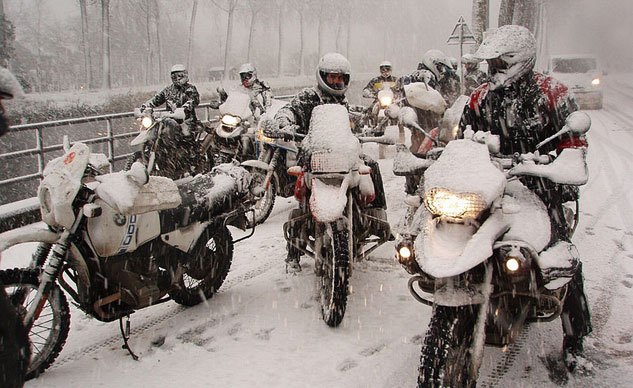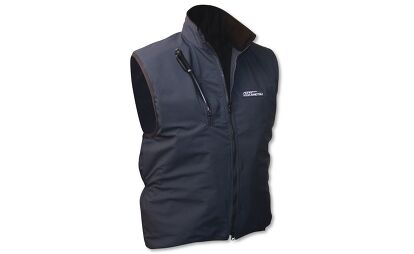Ask MO Anything: Can I Make My Own Heated Clothing?
A DIY-er wants to stay warm and save money
Dear MOby,
I need to make or acquire some heated gear. I notice that my chest is what gets cold first, toes next, so I’m looking into a heated vest. I’ve read that they don’t last very long… that is, the heaters don’t. I’ve already had a Heat Demon seat heater go bad (nearly burned my leg and it put a hole in the seat vinyl) after about four months of use, so I don’t have a good first impression of the heaters.
Heated gear for motorcycles specifically seems quite expensive. On the other hand, the Milwaukee 12-volt heated vest is reviewed to be durable and well built, but I’ve no information on heater longevity. And I don’t need the battery, as I’ll be powering it from the bike’s electrical system. If a Milwaukee 12V vest without the battery exists (I doubt it…haven’t found one) it should cost me about $70 which would be worth it if the heating element will last. The vest with the battery is about $120 and the battery is around $50, so….
So what about heated gear, especially a vest for starters? Durability? Longevity? Something that doesn’t break the bank? Of course, I’m planning to get into Klim gear just as soon as I make my first million as a rock star. That may be a while, so, meanwhile I still want to ride and stay warm.
I am a DIYer… I make my own crash bars, saddlebags, carrier racks, etc., so have thought about making a vest. I’d put thin aluminum sheet metal in pockets in the chest area, one either side of the zipper, handlebar-warmer size. Blocks the wind totally, spreads the warmth, protects the heater pads and they’re removable so the vest can be washed… though when does anybody wash their motorcycle gear? What the heck, it’s just an idea to try it. Part of the research, though, is finding reasonably priced gear, a vest in this case, that actually works well and reliably. Your take on this?
Thanks,
Paul Kenyon
Someplace Cold
Well, we’re California weenies, so we probably don’t give our electric gear quite the work-out riders in colder climates do – but my own Aerostich Kanetsu vest has got to be at least 15 years old, and the last time I plugged it in last winter, its lovely warmth continued to shine through. Before that, I had a Gerbing that also never let me down and probably is still in the closet somewhere. I only retired it because the Kanetsu vessel is nice, soft fleece. Looks like the Kanetsu is up to $187 now, which isn’t cheap, but if your chest is your main complaint, you could have a look at Aerostich’s $77 Warmbib Evans B reviewed in MO last year. Meanwhile, Gerbing’s basic motorcycle vest sells for $125 here, and looks much nicer than my old one.
If you really wanted to build your own, a conversation with Aerostich founder Andy Goldfine leads us to believe it’s nothing like rocket science. All you need are the right materials and a little sewing skill; Goldfine says a dual-sport rider friend even made himself a heated chest protector.
Lots of materials get warm when you run electricity through them, including carbon fiber, but the oldest and simplest is the specialized heating wire people have been putting into electric heating pads, electric blankets, car seats and all kinds of things for decades. Googling “resistance heating wire” brings up almost 7M results. Andy says Aerostich uses wire with a nichrome filament wrapped spirally around a core covered with a flexible insulation, mostly because it can flex a lot without breaking:
“It is available in various resistance levels (sizes), and the amount of heat produced varies by the length of the wire being used in the circuit. We use two resistance levels of wire in various products and locations, and in varying lengths, depending on how much heat we want. This wire can get hot enough to cause pretty severe skin burns, so one needs to be careful when figuring out how much of what gauge wire to use. Trial and error testing and ohms-law math are both useful here.”
This is the part where most of us just pays our money…
Once you figure out how much to use, the wire is arranged in a back and forth pattern so it doesn’t cross itself, with both ends coming together only at the connection to the cord going to the bike’s electrical system.
Goldfine again: “A hot glue gun works very well for sticking the wire to the fabric of the garment, as the adhesive melts at a higher temp than the wire will ever reach. Here we put a dab of glue on the wire every few inches, holding it to a non-woven heat-adhesive fabric called ‘fusible pellon.’ Then we put another piece of this pellon on top of the wire so we have a pellon-wire-pellon sandwich, and the whole thing goes into a huge heated press where it’s heat-fused together. This assembly is then sewn inside the garment. A do-it-yourselfer could probably skip the pellon and use use any kind of light fabric and the hot glue, then sew the completed panel into the inside of whatever garment they want.”
That’s about all there is to it, says Goldfine: Wire + inner fabric + hot melt glue = panel to sew inside any garment.
Going the extra mile as we’re so fond of doing here at MO, we found true cheapskate advice over here at Instructables.com, from one Cowboy 3059:
“Another idea for making heated clothing for bikes is go to a truck stop or eBay and buy a 12-volt heated blanket, usually for about $35. Strip the wiring out, buy a roll of metal duck (sic) tape from Home Depot for about $7, run the wires inside on the leather in a back-and-forth pattern taping it down with the metal tape. Run the cord, with thermostat, out the bottom so it doesn’t interfere with your riding and connect to power source. They come with a prewired fused lighter plug. You’re ready to rock and roll, took me about two hours start to finish.”
Wow. Let us know how it turns out, Paul, and thanks for the advice Andy Goldfine at Aerostich.
Direct your motorcycle-related questions to AskMoAnything@motorcycle.com, though some say we’re better at non-motorcycle-related ones…
More by John Burns
































Comments
Join the conversation
Be sure to include some kind of thermostat/voltage regulator, and remember...
"Build a man a fire, and he'll be warm for a day. Set a man on fire, and he'll be warm for the rest of his life." - Terry Pratchett
I find that loose-fitting belted greatcoat works especially well, if I put several labrador retriever puppies in there -- four or five fill the extra space in the coat. Also, a family of mice in each mitten add surprising warmth. I'm Canadian, so I'm hip to these old-school heated gear tips.